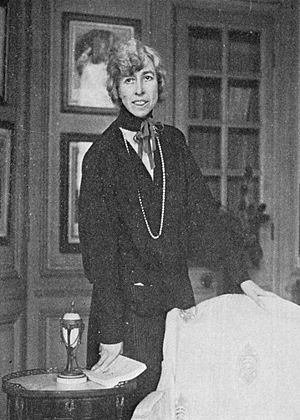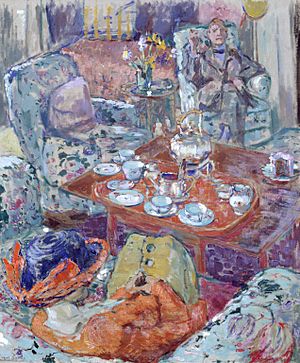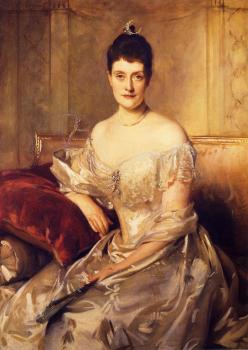Ethel Sands facts for kids
Quick facts for kids
Ethel Sands
|
|
|---|---|

Ethel Sands at home in the Vale, Chelsea 1922, photograph, private collection
|
|
| Born | 6 July 1873 Newport, Rhode Island, U.S.
|
| Died | 19 March 1962 (aged 88) London, England
|
| Nationality |
|
| Education | Eugène Carrière |
| Known for | Painting |
Ethel Sands (born 6 July 1873 – died 19 March 1962) was an artist and a well-known hostess. She was born in America but lived in England for most of her life. Ethel studied art in Paris, France, where she met her close friend and partner, Anna Hope Hudson (Nan).
Ethel Sands mostly painted still lifes (pictures of objects) and interiors (pictures of rooms). Many of her paintings showed the inside of Château d'Auppegard, a home she shared with Nan Hudson. She was a member of important art groups like the Fitzroy Street Group and London Group. Her paintings are displayed in famous places like the National Portrait Gallery in London. In 1916, she became a British citizen. Ethel Sands was also known for hosting parties for famous artists and writers, including Henry James, Virginia Woolf, and Roger Fry.
Contents
Early Life and Family
Ethel Sands was born on 6 July 1873, in Newport, Rhode Island, USA. She was the first child of Mary Morton Hartpence and Mahlon Day Sands. Her father was involved in business and supported ideas like free trade. Ethel had two younger brothers, Mahlon Alan and Morton Harcourt.
In 1874, when Ethel was very young, her family moved from the United States to England. They also traveled around Europe and visited the United States every year. They kept their house in Newport, Rhode Island, for many years.
The Sands family was wealthy and spent time with important people in London society. These included writers like Henry James and politicians like William Ewart Gladstone. The famous artist John Singer Sargent painted a portrait of Ethel's mother, who was known for her beauty.
Ethel grew up in a loving, upper-class home. Her father died in 1888 after falling from his horse. Her mother, Mary Sands, raised Ethel and her brothers until she passed away in 1896.
Becoming an Artist

Art Education in Paris
Ethel Sands was encouraged by the artist John Singer Sargent to study painting. In 1894, she began studying at the Académie Carrière in Paris under Eugène Carrière. It was there that she met Nan Hudson, who became her close friend and partner. After her mother died in 1896, Ethel also became the guardian of her two younger brothers.
Her Painting Style
Ethel Sands was known for painting still lifes and indoor scenes. Her style was influenced by the French artist Édouard Vuillard, especially his use of color and way of showing everyday, personal moments. Her first art show was in Paris in 1904.
In 1907, she joined the Fitzroy Street Group at the invitation of artist Walter Sickert. She also helped start The London Group, another important art association. At the time, art by women like Ethel Sands and Vanessa Bell was often seen differently from art by men. Women's art might be called "individual," but not always "modern" or "innovative."
Ethel Sands had her first solo art show in Paris in 1911. She and Nan Hudson also had a show together in 1912. Her art was shown in many galleries, and she had her first solo show in London in 1922. She also often exhibited her work at the Women's International Art Club and the New English Art Club.
In 1920, Nan Hudson bought Château d'Auppegard in France. This house became the subject of many of Ethel's paintings, such as A Spare Room, Château d'Auppegard and Double Doors, Château d'Auppegard. Her art can be found in collections like the Tate museum and the Fitzwilliam Museum.
A Famous Hostess and Supporter of Art
Ethel Sands was known as a "hostess," meaning she loved to entertain guests at her home. She invited many artists and writers to her parties to talk about their ideas and careers. She was connected to the Bloomsbury Group, a famous group of writers and artists. Ethel inherited a lot of money from her parents, which allowed her to host these grand gatherings.
She entertained guests at her homes in Oxford, London, and Chelsea. Her Chelsea home was near her mother's friend, Henry James. Famous visitors included artists Augustus John and Walter Sickert, and writers like Henry James, Virginia Woolf, and Roger Fry. Her friends also included writer Edith Wharton and poet William Butler Yeats.
-
Edwin Lawrence Godkin, her uncle, a journalist and editor
-
Henry James, writer, neighbor and close friend of the family
-
Walter Sickert, artist and mentor
Ethel Sands was also a "patron" of art, meaning she supported other artists and collected their works. For example, she asked Boris Anrep, a Russian artist, to create mosaics and murals in her Chelsea home. She continued to entertain friends like Duncan Grant until the 1950s.
World Wars and Their Impact
During World War I, Ethel Sands helped injured soldiers in France. She and Nan Hudson set up a hospital near Dieppe. When it closed, they continued nursing in both France and England. Ethel also worked as a forewoman in a factory that made overalls. In 1916, she became a British citizen.
During World War II, Ethel Sands again served as a nurse. Sadly, her house in Chelsea, London was destroyed during The Blitz (bombings of London), and her house in France was robbed. Because of these events, most of Ethel Sands' and Nan Hudson's artworks were lost or destroyed.
Later Life
Ethel Sands and Nan Hudson split their time between England and France. Nan preferred a quiet life in France, while Ethel enjoyed the social scene in London and Oxford.
Ethel continued to entertain people throughout her life. When Nan Hudson's health declined, Ethel cared for her until Nan passed away in 1957. Ethel Sands died on 19 March 1962.
The writer Virginia Woolf, a friend of Ethel's, wrote a short story inspired by her called "The Lady in the Looking Glass." An art historian named Wendy Baron wrote a book about Ethel Sands, using letters Ethel exchanged with Nan Hudson and others. These letters are now kept in the Tate Archives.
Ethel Sands was given the title Dame in 1920, which is a high honor in Britain.
Works
Here are some of Ethel Sands' paintings that survived the wars:
- A Dressing Room, oil on millboard, 46 x 38 cm, The Ashmolean Museum of Art and Archaeology.
- A Spare Room, Château d'Auppegard, about 1925, oil on board, 44.5 x 53.5 cm, Government Art Collection.
- Auppegard Church from the Château, France, oil on canvas, 60 x 48 cm, City of London Corporation.
- Bedroom Interior, Auppegard, France, oil on canvas, 60 x 48 cm, City of London Corporation.
- Double Doors, Auppegard, France, oil on canvas, 53 x 45 cm, City of London Corporation.
- Figure Seated by an Open Window, oil on canvas, 60 x 48 cm, City of London Corporation.
- Flowers in a Jug, 1920s, oil on canvas, Tate.
- Girl Reading on a Sofa, Auppegard, France, oil on canvas, 53 x 46 cm, City of London Corporation.
- Girl Sewing, Auppegard, France, oil on canvas, 49 x 60 cm, City of London Corporation.
- Interior at Portland Place, London, oil on canvas, 43 x 58 cm, City of London Corporation.
- Interior with Mirror and Fireplace, oil on canvas, 65 x 53 cm, City of London Corporation.
- Interior with Still Life and the Statuette of the Madonna, oil on canvas, 67.3 x 58.5 cm, Amgueddfa Cymru – National Museum Wales.
- (Lloyd) Logan Pearsall Smith, 1932, oil on canvas, 61.4 x 49.8 cm, National Portrait Gallery, London.
- Nan Hudson Playing Patience at Auppegard, France, oil on canvas, 64 x 52 cm, City of London Corporation.
- Still Life with a View over a Cemetery, oil on board, 45 x 37.5 cm, The Fitzwilliam Museum.
- Still Life with Books and Flowers, oil on canvas, 36 x 44 cm, City of London Corporation.
- Tea with Sickert, about 1911–12, oil on canvas, 61 x 51 cm, Tate.
- The Bedroom at Auppegard, France, Girl Reading, oil on canvas, 51 x 61 cm, City of London Corporation.
- The Chintz Couch, about 1911–12, oil on board, 46.5 x 38.5 cm, Tate.
- The Open Door, Auppegard, France, oil on canvas, 54 x 45 cm, City of London Corporation.
See also
 In Spanish: Ethel Sands para niños
In Spanish: Ethel Sands para niños






